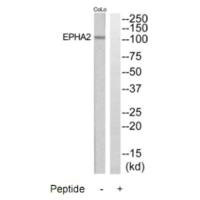
Western blot analysis of extracts from COLO205 and Jurkat cells, using EPHA2 antibody.
EPHA2 Antibody

CSB-PA282887
ApplicationsWestern Blot, ELISA
Product group Antibodies
ReactivityHuman
TargetEPHA2
Overview
- SupplierCusabio
- Product NameEPHA2 Antibody
- Delivery Days Customer20
- ApplicationsWestern Blot, ELISA
- CertificationResearch Use Only
- ClonalityPolyclonal
- ConjugateUnconjugated
- Gene ID1969
- Target nameEPHA2
- Target descriptionEPH receptor A2
- Target synonymsARCC2; CTPA; CTPP1; CTRCT6; ECK; ephrin type-A receptor 2; epithelial cell receptor protein tyrosine kinase; soluble EPHA2 variant 1; tyrosine-protein kinase receptor ECK
- HostRabbit
- IsotypeIgG
- Protein IDP29317
- Protein NameEphrin type-A receptor 2
- Scientific DescriptionReceptor tyrosine kinase which binds promiscuously membrane-bound ephrin-A family ligands residing on adjacent cells, leading to contact-dependent bidirectional signaling into neighboring cells. The signaling pathway downstream of the receptor is referred to as forward signaling while the signaling pathway downstream of the ephrin ligand is referred to as reverse signaling. Activated by the ligand ephrin-A1/EFNA1 regulates migration, integrin-mediated adhesion, proliferation and differentiation of cells. Regulates cell adhesion and differentiation through DSG1/desmoglein-1 and inhibition of the ERK1/ERK2 (MAPK3/MAPK1, respectively) signaling pathway. May also participate in UV radiation-induced apoptosis and have a ligand-independent stimulatory effect on chemotactic cell migration. During development, may function in distinctive aspects of pattern formation and subsequently in development of several fetal tissues. Involved for instance in angiogenesis, in early hindbrain development and epithelial proliferation and branching morphogenesis during mammary gland development. Engaged by the ligand ephrin-A5/EFNA5 may regulate lens fiber cells shape and interactions and be important for lens transparency development and maintenance. With ephrin-A2/EFNA2 may play a role in bone remodeling through regulation of osteoclastogenesis and osteoblastogenesis. Bentley D.R., Nature 441:315-321(2006). White F.M., Mol. Cell. Proteomics 4:1240-1250(2005). Daub H., Mol. Cell. Proteomics 6:537-547(2007).
- ReactivityHuman
- Storage Instruction-20°C or -80°C
- UNSPSC12352203
